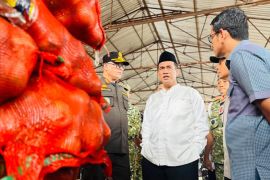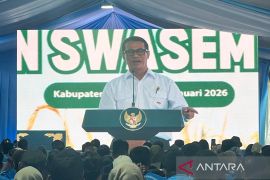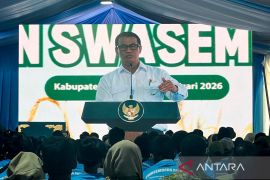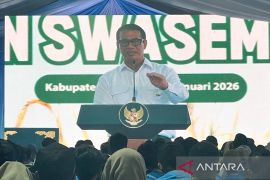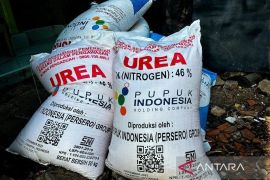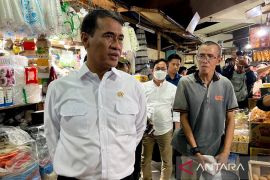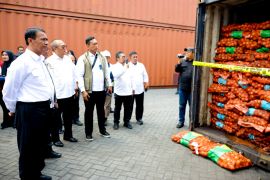This is especially important for Indonesia, given that its agricultural sector has a significant contribution to the economy.
Statistics Indonesia (BPS) recorded that this sector contributed 11.77 percent to the national gross domestic product (GDP) in the first quarter of 2023 and absorbed 29.36 percent from the total working population in February 2023.
To create accurate policies in the agriculture sector, the government requires accurate, factual, and up-to-date data.
In welcoming the launch of the implementation of the 2023 Agriculture Census, President Joko Widodo (Jokowi) remarked that accurate agriculture sector data will be able to handle various issues in the agriculture sector, such as subsidized fertilizer distribution.
Due to this, he supports the implementation of the 2023 Agriculture Census that is expected to be able to describe the latest condition in the domestic agriculture sector comprehensively.
Agriculture census is implemented once every 10 years based on Law No. 6 of 1997 on BPS and Food and Agriculture's (FAO's) recommendation.
The agriculture census is the only data-gathering instrument that can produce agriculture data up to the smallest region.
The 2023 Agriculture Census became the seventh census carried out by Indonesia since first being held in 1963.
Raising the theme of "Recording Indonesian Agriculture for Food Sovereignty and Farmer Prosperity," the result of the 2023 Agriculture Census is expected to be a valid foundation for policy formulation in agriculture.
The census that will be held from June 1 to July 31, 2023, is intended to capture changes in the Indonesian agriculture structure within the last 10 years.
Data from the census can be utilized as a sample framework for surveys that will be held between two censuses to gather a more detailed agriculture statistics.
The data can be used as a benchmark and reconciliation from existing agricultural statistics.
Detailed agriculture data
As a major activity, the 2023 Agriculture Census comprises a series of activities starting with planning, preparation, data gathering, presentation, and data analysis.
Data collection in census also encompasses seven agricultural subsectors: food crop, horticulture, plantation, fishery, agriculture, forestry and agricultural service.
The produced data came in the form of the Indonesian agriculture sector, small farmers' condition, sustainable development in agriculture indicators, agriculture geospatial statistics, and agricultural management.
Head of BPS Margo Yuwono said that the produced data also encompasses agricultural land area by use, agriculture commodity production, and the number of Micro, Small and Medium Enterprises (MSMEs) in agriculture.
Through the 2023 Agriculture Census, Yuwono noted, the government will also update the system to gather data on small-scale farmers and draw conclusion from it.
Earlier, small-scale farmers were only measured on the basis of ownership of land less than 0.5 hectares.
Meanwhile, in the 2023 Agriculture Census, small-scale farmers' categorization is not only based on land ownership but also the number of livestock assets and monthly income adjusted based on their respective regions.
The 2023 Agriculture Census will also produce agriculture business data sorted by name and by address.
This data is expected to be used as a reference point to know the accurate target from the government's programs in agriculture, such as subsidized fertilizer distribution.
By knowing the number of Indonesian farmers and their age, the government also expects that this will provide a clear picture related to the domestic farmers' regeneration condition.
This is important, so that Indonesia can immediately take actions to anticipate the issue of aging farmers that is also occurring in the world.
The 2023 Agriculture Census had begun since 2021, and the activity is planned to end in 2024.
Respondents within the census comprise agricultural businesses, both individual and collective.
Synergy with the ministry and institution
The success of the 2023 Agriculture Census certainly necessitates collaboration involving various parties.
Hence, to this end, BPS has received support from the Agriculture Ministry, Marine Affairs and Fishery Ministry, as well as Environment and Forestry Ministry to implement the 2023 Agriculture Census.
In its implementation, the 2023 Agriculture Census will also involve 190 thousand census workers spread across Indonesia.
Data produced by the census is expected to create more accurate programs from various ministries and institutions that do not overlap with one another.
The president also expects that in future, the Agriculture Census can be conducted once every five years, so that comprehensive data related to the agriculture sector can be updated with faster tempo.
In response, Agriculture Minister Syahrul Yasin Limpo said he will support the step to conduct the Agriculture Census once every five years, so that the government can continue to have complete agriculture sector data.
Related news: Agriculture Ministry's task force to handle El Nino in June
Related news: Indonesia, South Korea ink MoU on agriculture
Related news: Expanding inspections of fishing vessels agreed at Bali FAO meeting
Translator: Sanya Dinda S, Fadhli Ruhman
Editor: Azis Kurmala
Copyright © ANTARA 2023

